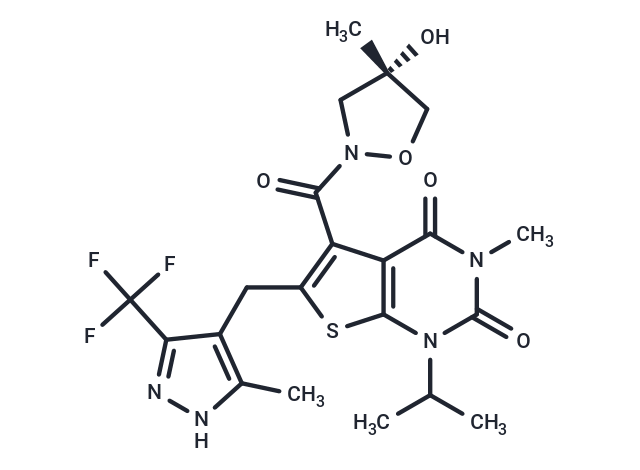Shopping Cart
- Remove All
 Your shopping cart is currently empty
Your shopping cart is currently empty

AZD3965 (AZD-3965) is a selective inhibitor of monocarboxylate transporter 1 (MCT1).

| Pack Size | Price | Availability | Quantity |
|---|---|---|---|
| 1 mg | $50 | In Stock | |
| 2 mg | $72 | In Stock | |
| 5 mg | $119 | In Stock | |
| 10 mg | $148 | In Stock | |
| 50 mg | $449 | In Stock | |
| 1 mL x 10 mM (in DMSO) | $135 | In Stock |
| Description | AZD3965 (AZD-3965) is a selective inhibitor of monocarboxylate transporter 1 (MCT1). |
| Targets&IC50 | MCT1:1.6 nM (Ki) |
| In vitro | In lymphoma cell lines that preferentially express MCT1, AZD3965 potently inhibits lactate transport and cell growth. [1] AZD3965 inhibits MCT1 activity in cells, and shows higher sensitivity in hypoxia. [2] In H526, HGC27 cells and DMS114 cells, AZD3965 increases intracellular lactate and significantly reduces lactate uptake. [3] |
| In vivo | In nonobese diabetic scid-γ mice bearing COR-L103 xenografts, AZD3965 (100 mg/kg, p.o.) reduces tumor growth and increased intratumor lactate. [2] In mice bearing H526 tumors, AZD3965 (100 mg/kg, p.o.) causes increased lactate concentration, a reduction in growth and increased radiation sensitivity. [3] |
| Kinase Assay | Cells are plated overnight and treated with 100 nM AZD3965 or vehicle for 24 hours. The cells are then washed, once in PBS and twice with lysis buffer (50 mM Mops, 100 mM KCl, 5 mM MgCl2, 1 mM EDTA, 0.1 mM DTT, 1 mM PMSF supplemented with 1× mini complete protease inhibitor cocktail tablets. The cells are harvested by scraping and centrifugation, and the pellet snap frozen without buffer in liquid nitrogen. Frozen aliquots of cells are thawed on ice and re-suspended in lysis buffer. Cells are lysed by 3 rounds of freezing in liquid nitrogen and thawing at 37°C for 2 minutes each. Lysates are subsequently centrifuged (13000 g, 10min, 4°C) until clear and then stored on ice. Enzyme activity in the cell lysates is determined using a micro-plate reader to measure either production or depletion of NADH/NADPH, through its absorbance at 340/10 nm, occurring as a result of direct or coupled enzyme reactions. The 96 well plates used for the assays are pre-heated to 37°C for 10 minutes prior to starting reactions, initiated by the addition of 5 μL cell lysate to 95 μL of reaction buffer (50 mM Mops pH 7.4, 100 mM KCl, 5 mM free magnesium). The standard reaction buffer is supplemented to assay the kinetics of the different enzymes. Absorbance values for controls are subtracted from absorbance of corresponding reactions. Graphpad prism 6 is used to plot V0 values against substrate concentration and determine Vmax and Km values. The Vmax is then normalised to the protein concentration in the cell lysate[1]. |
| Alias | AZD-3965, AZD 3965 |
| Molecular Weight | 515.51 |
| Formula | C21H24F3N5O5S |
| Cas No. | 1448671-31-5 |
| Smiles | CC(C)n1c2sc(Cc3c(C)[nH]nc3C(F)(F)F)c(C(=O)N3C[C@](C)(O)CO3)c2c(=O)n(C)c1=O |
| Relative Density. | 1.483 g/cm3 (Predicted) |
| Storage | Powder: -20°C for 3 years | In solvent: -80°C for 1 year | Shipping with blue ice. | |||||||||||||||||||||||||||||||||||
| Solubility Information | Ethanol: 100 mg/mL (193.98 mM), Sonication is recommended. DMSO: 100 mg/mL (193.98 mM), Sonication is recommended. H2O: < 1 mg/mL (insoluble or slightly soluble) | |||||||||||||||||||||||||||||||||||
Solution Preparation Table | ||||||||||||||||||||||||||||||||||||
Ethanol/DMSO
| ||||||||||||||||||||||||||||||||||||

Copyright © 2015-2025 TargetMol Chemicals Inc. All Rights Reserved.